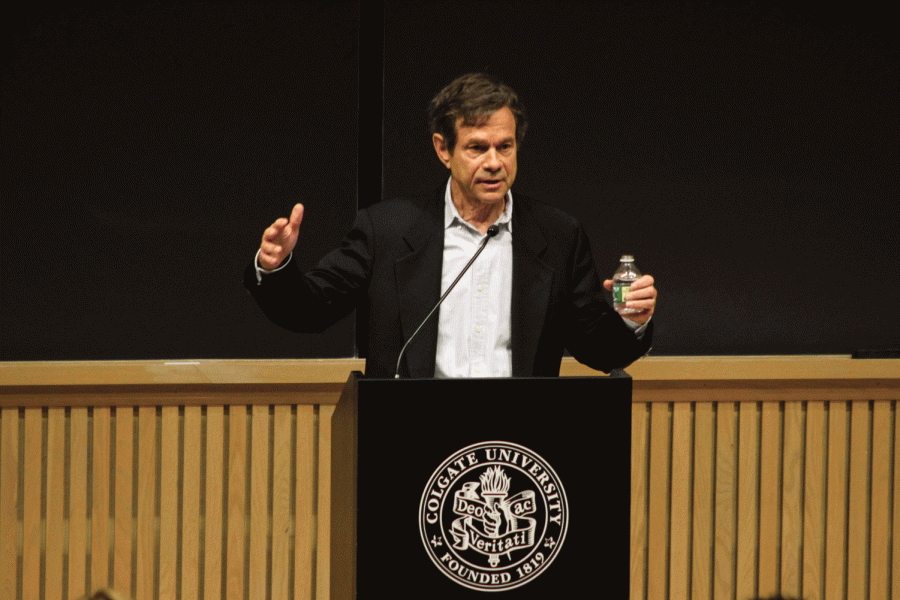Lightman Presents Work That Transcends Academic Disciplines
Students, faculty and local residents gathered in Love Auditorium on Thursday, October 26, to experience the latest installment of Colgate’s Living Writers Series. Associate Professor of English Jennifer Brice gave Alan Lightman, an accomplished author and professor of the practice of the humanities at MIT, a introduction that highlighted the duality of Lightman’s intellectual interests.
He has been described as a physicist-turned-creative writer, a contrast that stood out when Brice described him as the only author in the thirty years that the Living Writers Series has existed who has been published both in The New Yorker and The Journal of Astrophysics. Lightman was in fact the first professor at MIT to teach simultaneously in the sciences and the humanities. Or, as Brice put it, to “on some days teach physics in the morning and creative writing in the afternoon.” He is best known as the author of the international bestseller Einstein’s Dreams. His other work, The Diagnosis, was a finalist for the National Book Award. Lightman has published 20 works of fiction, non-fiction and poetry. His memoir, Screening Room, was named by The Washington Post as one of the best books of 2015. His latest essay collection, Accidental Universe, was the work featured in this installment of Living Writers.
Brice pointed out that one of the best things about reading an essay of Lightman’s is that you immediately feel smarter after reading it. This idea was the general takeaway from this talk, for both those who had read Accidental Universe and for those who simply listened to Lightman speak about it. Lightman focused much of his talk on idea of the multiverse, something covered in Accidental Universe. His overall goal with his latest work, and with this talk, was to show the impact of modern science on our understanding of ourselves and our place in the universe.
Lightman went into great detail about the multiverse, starting with the fact that scientists have long thought that it was only possible for one universe to exist: our universe. Lately, however, scientists have learned that this idea is probably wrong. The idea of there being multiple universes, with ours just accidentally happening to contain certain fine tuned parameters that allow for life, is an idea that is becoming widely accepted, as it explains certain things scientists could not explain before. This theory is upsetting to some scientists, however, who are used to being able to explain everything through a few fundamental principles.
For example, scientists have recently discovered a new kind of energy in the universe that we can’t see: dark energy. It makes the universe expand faster and faster as time goes on. If the amount of dark energy was even a tiny bit more than what it is, everything would be moving apart from each other so fast that nothing could form in our universe.
What is the explanation for the existence of such a fine tuned parameter that just barely allows for life? Lightman described how some people use intelligent design as an explanation, believing that the universe must care about life, and that is why the perfect conditions for life exist. Another explanation is the multiverse, which says that our universe has all of the correct parameters for life simply by chance.
It is incredible that Lightman has his PhD in theoretical physics, making significant contributions to the scientific community, but is also able to write in such a compelling way that he has become a best-selling author. The audience was able to experience a snippet of his beautiful prose when Lightman read an excerpt from Accidental Universe that focused on the emotions he felt watching his daughter get married and grow older. This reading centered on the idea of impermanence, and showed the reason why Lightman is so dynamic both as a scientist and as a writer. With this reading, he touched the souls of those gathered in Love Auditorium in a way he wasn’t able to when simply discussing scientific theories like the multiverse. Here, he made each and every person in the audience consider the idea of their own impermanence, an area of thought that is too dark for most to go to. But the language with which he described watching his daughter grow older made it so that everyone, including young students, could feel his emotions.
Lightman closed the talk with a question-and-answer portion, during which an interesting question was posed comparing scientists’ faith in theories they cannot prove, such as string theory or the idea of the multiverse, to religious faith. This question nicely wrapped up the talk and its focus on belief in things that cannot be explicitly proven, and left listeners with much to think about.
Contact Karrie Spychalski at [email protected].







